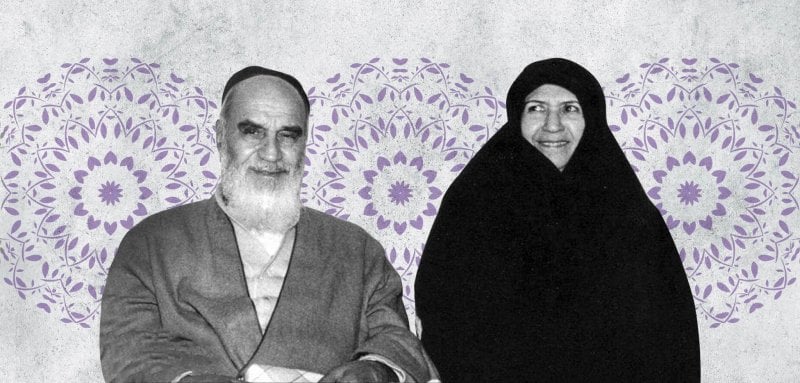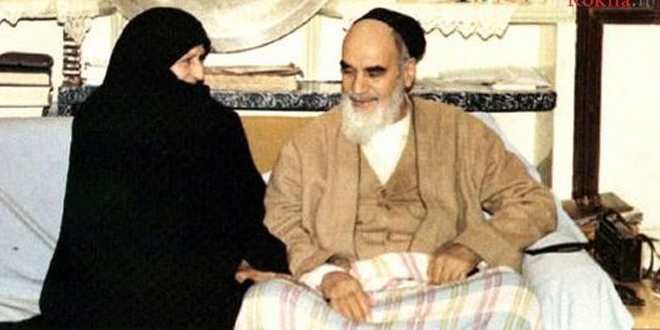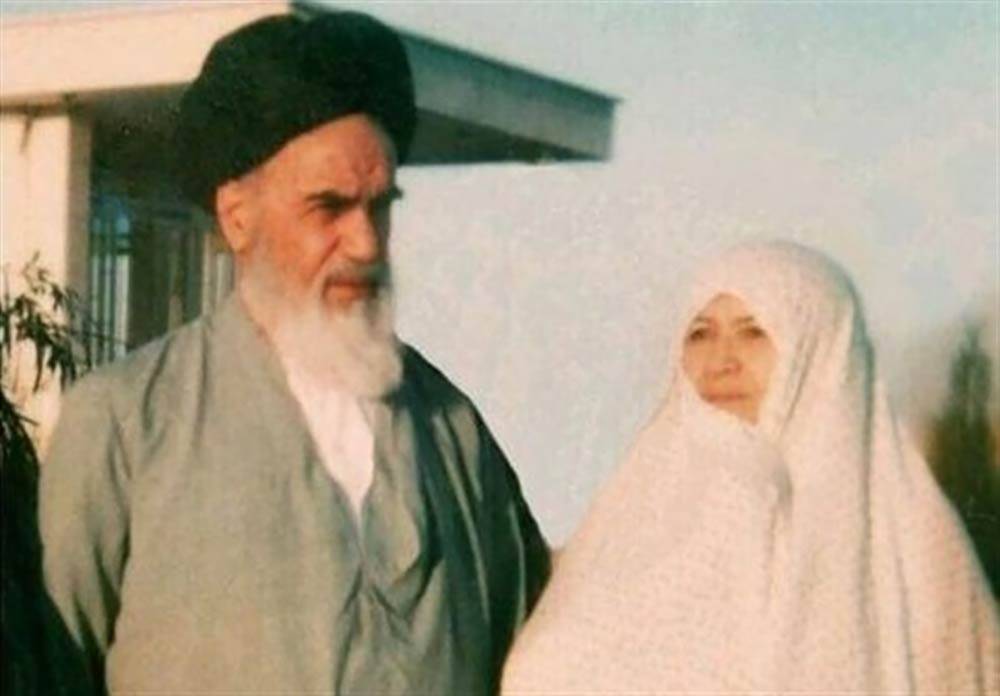Did Ayatollah Khomeini Have A Wife? Uncovering The Life Of Khadijeh Saqafi
Detail Author:
- Name : Prof. Chaz Pollich IV
- Username : kovacek.royce
- Email : ypagac@gmail.com
- Birthdate : 1987-08-17
- Address : 43667 Mraz Causeway Apt. 698 Camdenshire, DE 63584-4896
- Phone : +1-202-904-0746
- Company : Hermann, Bednar and Glover
- Job : Textile Dyeing Machine Operator
- Bio : Ut eos at quibusdam velit. Placeat esse dolorem laboriosam quia velit hic. Suscipit perferendis debitis accusamus autem.
Socials
instagram:
- url : https://instagram.com/lavern.flatley
- username : lavern.flatley
- bio : Amet omnis modi hic atque maiores. Aliquid laboriosam nihil unde.
- followers : 1474
- following : 1361
tiktok:
- url : https://tiktok.com/@lavern_flatley
- username : lavern_flatley
- bio : Tempora perferendis esse ab at incidunt deleniti.
- followers : 5711
- following : 1683
facebook:
- url : https://facebook.com/lavern_flatley
- username : lavern_flatley
- bio : Dolor minima quia laborum suscipit occaecati debitis repellendus.
- followers : 1049
- following : 91
linkedin:
- url : https://linkedin.com/in/lavern.flatley
- username : lavern.flatley
- bio : Omnis non quam eligendi ducimus.
- followers : 1637
- following : 2408
twitter:
- url : https://twitter.com/lavern_flatley
- username : lavern_flatley
- bio : Sed fuga illum quis natus itaque aut. Animi sed distinctio dolores fuga.
- followers : 1296
- following : 2792
Have you ever wondered about the personal side of historical figures, particularly those who shaped nations? When we think of Ayatollah Ruhollah Khomeini, the central figure of Iran's Islamic Revolution, his public persona often comes to mind first, yet there's a quieter, equally significant story about his personal life that many might not know. It's a question that, you know, often sparks curiosity.
So, did Ayatollah Khomeini have a wife? The answer, as a matter of fact, is a definite yes, and her story is quite compelling. She played a remarkably important role, not just in his private world, but also, in a way, in the broader historical events that unfolded around them.
Her name was Khadijeh Saqafi, a lady whose quiet resilience and deep commitment were, quite frankly, a pillar for the leader and his cause. We'll be looking at her life, her marriage, and the legacy she left behind, offering a fuller picture of this influential couple, and you might find it quite interesting.
Table of Contents
- The Life Story of Khadijeh Saqafi
- Personal Details: Khadijeh Saqafi
- A Marriage Begins: Overcoming Initial Doubts
- Family Life and Children
- The "Mother of the Islamic Revolution"
- A Husband's Deep Appreciation
- A Pillar of Support Through Tumultuous Times
- The Family's Continuing Story
- Frequently Asked Questions
- A Lasting Impression
The Life Story of Khadijeh Saqafi
Khadijeh Saqafi, the woman who would become Ayatollah Ruhollah Khomeini's wife, began her life in Tehran, the capital city, back in 1913. She was born into a family with a strong connection to religious scholarship and practice, which, you know, really shaped her early years. Her background was deeply rooted in the traditions of clergymen, providing a very specific kind of upbringing.
Her father was a respected figure himself, Ayatollah Mirza Mohammad Saqafi. He was a scholar who had even written an important interpretation of religious texts, an exegesis. This heritage meant that Khadijeh grew up in an environment where religious learning and piety were highly valued, almost like a constant presence in her daily existence. It’s fair to say, this background likely prepared her for the very public and challenging life she would eventually share.
So, her family's standing in the community, particularly within religious circles, meant that she was raised with certain expectations and, you know, a particular way of looking at the world. This foundation would prove incredibly important as her life unfolded, especially considering the path her future husband would take. She was, in some respects, destined for a life of quiet influence.
Personal Details: Khadijeh Saqafi
| Full Name | Khadijeh Saqafi (also known as Khadija Saqafi, Khadijeh Saghafi) |
| Born | 1913 |
| Birthplace | Tehran, Iran |
| Father | Ayatollah Mirza Mohammad Saqafi |
| Spouse | Ayatollah Ruhollah Khomeini |
| Marriage Age | 16 years old |
| Children | 8 (3 sons, 5 daughters; 5 survived to adulthood) |
| Known For | "Mother of the Islamic Revolution," "Holy Lady of Iran," "Lady of the Revolution," Wife and aide to Ayatollah Khomeini |
A Marriage Begins: Overcoming Initial Doubts
The story of Khadijeh Saqafi's marriage to Ruhollah Khomeini is, you know, quite interesting, particularly because it wasn't a straightforward affair from the start. She was just 16 years old when she tied the knot with him, a common age for marriage in those times, but the path to their union had a few bumps along the way. Her family, it seems, had some very real concerns about the match.
In fact, her family actually turned down Khomeini's proposals not just once, but three separate times. Their hesitation stemmed from a very practical worry: they weren't entirely confident about Khomeini's financial prospects at that point. He was, in a way, still establishing himself, and they probably wanted a bit more security for their daughter. It’s a classic story of parental concern for a child's future, really.
Despite these initial rejections, Khomeini persisted, and eventually, the family agreed. This perseverance suggests a deep commitment on his part, and perhaps a growing trust from her family in his character, even if his financial standing wasn't yet what they might have hoped for. This early hurdle, you know, set the stage for a partnership that would weather many storms.
Family Life and Children
Once married, Ayatollah Khomeini and Khadijeh Saqafi began building their family, which eventually grew quite large. They were blessed with eight children in total, a rather big family by any measure. Among these children were three sons and five daughters, creating a lively household, you can imagine.
However, like many families of that era, they also experienced profound sadness. Three of their children passed away while they were still very young, a truly heartbreaking experience for any parent. This loss, you know, must have been incredibly difficult to bear, adding a layer of quiet grief to their lives.
Despite these early tragedies, five of their children survived and grew to adulthood. These surviving children would go on to live their own lives, some becoming involved in different aspects of society, and some, in a way, stepping away from the direct political spotlight that their father commanded. The family unit, through all its joys and sorrows, remained a central part of their shared existence.
The "Mother of the Islamic Revolution"
Within Iran, Khadijeh Saqafi became known by a truly significant title: the "Mother of the Islamic Revolution." This wasn't just a casual nickname; it reflected the deep respect and affection people held for her, seeing her as a guiding presence behind the scenes. She was also called the "holy lady of Iran" or the "lady of the revolution," which, you know, speaks volumes about her public perception.
Her influence wasn't about public speeches or political rallies; it was a quieter, more profound kind of impact. She was widely seen as a wise and patient woman, qualities that are, quite frankly, deeply admired in any leader's spouse. Her calm demeanor and inner strength provided a steady anchor, especially during turbulent times. It’s almost as if her presence radiated a sense of calm.
She was, in essence, a consistent supporter and aide to the founder of the Islamic Republic. Her role was less about direct action and more about being a constant source of encouragement and understanding for her husband. This quiet strength, you know, made her a revered figure in her own right, earning her these very special titles.
A Husband's Deep Appreciation
Ayatollah Khomeini himself held a very deep and open appreciation for his wife, Khadijeh. He often spoke of her in incredibly warm and respectful terms, which is, you know, quite telling about their relationship. His words revealed a partnership built on mutual regard and a clear understanding of the sacrifices she made.
He once famously said, "Blessed am I that I have such a wife." This sentiment alone shows the high esteem in which he held her. He recognized her contributions, perhaps in a way that many public figures don't always acknowledge their partners. He didn't just appreciate her; he truly valued her presence and her character.
He continued, saying, "No one else has sacrificed as much in life as she has." This statement really highlights his awareness of the personal costs she bore as the wife of a revolutionary leader, a man who faced exile and intense political struggle. He even used her as an example for others, suggesting, "If you too would be like khanom, your husband would also like you this much." This, you know, speaks volumes about the respect and admiration he had for her traditional marriage customs and her personal qualities.
Imam Khomeini's dear wife, Lady Khadijeh Saqafi, frequently appreciated the great ethical norms practiced by the great spiritual leader within and outside the family environment. This mutual appreciation, in a way, painted a picture of a relationship built on shared values and deep respect for each other's moral standing. It seems they truly saw the best in one another.
A Pillar of Support Through Tumultuous Times
Khadijeh Saqafi's role as a supportive partner became especially clear during some of the most challenging periods in Ayatollah Khomeini's life. For instance, when Imam Khomeini was arrested and sentenced to death back in 1963, a truly frightening moment for the family, her reaction was quite remarkable. She showed, you know, an incredible amount of tolerance and fortitude.
During this intensely difficult time, their home transformed into a gathering place for many concerned people. It became a hub where supporters, family members, and those worried about Khomeini's fate could come together, seek comfort, and perhaps find some direction. This openness and willingness to offer their home as a refuge speaks volumes about her character.
Imam Khomeini's wife, known as the holy lady of Iran or the lady of the revolution, was indeed a wise and patient woman. Her ability to remain calm and steady under such immense pressure was a source of strength for many around her. If one pays attention to her patience, one easily finds that it was a truly extraordinary quality, a deep well of resilience that, you know, sustained her and those around her.
Her steadfastness during these trials was not just a personal trait; it was, in some respects, a quiet act of support for the larger movement. She remained a backer and aide to the founder of the Islamic Republic, offering unwavering loyalty and practical assistance whenever it was needed. This kind of silent strength is, you know, often overlooked but incredibly powerful.
The Family's Continuing Story
While Ayatollah Khomeini was the face of Iran’s revolution, the family he built with Khadijeh Saqafi has, over time, largely stepped away from the country’s direct political scene. Khomeini and his wife, Khadijeh Saghafi, had five children who survived to adulthood, and they also had fifteen grandchildren, so a really extensive family tree.
One of their descendants, Hussain Khomeini, born in 1959, is the son of Mostafa Khomeini, who was one of Ayatollah Khomeini's sons. Hussain himself is a cleric, but he is also known for being a liberal secularist and has become an outspoken critic of the current theocratic government in Iran. This, you know, shows a divergence in political views within the family, which is quite interesting.
Another family connection is Masoumeh Haeri, who is Mostafa Khomeini’s widow. She is also the granddaughter of Abdul Karim Haeri Yazdi, who founded the Qom seminary, a very important religious institution. These connections show the deep roots the family has within Iran's religious and intellectual circles, even as their direct political involvement has, in a way, lessened.
Ayatollah Ali Khamenei, who succeeded Ayatollah Khomeini as the supreme leader of Iran on June 4, 1989, also has his own family story. He married his wife, Mansoureh Khojasteh, when she was under seventeen years old. Though many grand ayatollahs opposed his appointment as he was not a marja or ayatollah at the time, his family life, you know, continued the tradition of early marriage seen in the region.
Frequently Asked Questions
People often have questions about the personal life of such a prominent figure. Here are some common inquiries:
Who was Ayatollah Khomeini's wife?
Ayatollah Khomeini's wife was Khadijeh Saqafi. She was born in Tehran in 1913 and came from a family of respected clergymen, her father being Ayatollah Mirza Mohammad Saqafi. She married Khomeini when she was just 16 years old, after her family initially had some reservations about his financial prospects. She was, you know, a very important figure in his personal life and was widely respected.
How many children did Ayatollah Khomeini have?
Ayatollah Khomeini and Khadijeh Saqafi had a total of eight children together. This included three sons and five daughters. Sadly, three of their children passed away when they were still young. However, five of their children survived to adulthood, and they eventually had fifteen grandchildren, so a pretty large family altogether, you know, with many descendants.
What was Khadijeh Saqafi known for?
Khadijeh Saqafi was widely known and deeply respected within Iran as the "Mother of the Islamic Revolution." She was also referred to as the "holy lady of Iran" or the "lady of the revolution." She was appreciated for her wisdom, patience, and unwavering support for her husband, particularly during his most challenging times, such as his arrest in 1963. She was, in a way, a quiet but very powerful presence.
A Lasting Impression
The story of Khadijeh Saqafi, the wife of Ayatollah Ruhollah Khomeini, truly offers a deeper look into the life of a historical figure often seen only through his public actions. Her quiet strength, unwavering support, and the deep appreciation her husband held for her paint a picture of a remarkable partnership. She was, you know, a central figure in his personal world, shaping his life in ways that might not always be obvious from the outside.
Her legacy, as the "Mother of the Islamic Revolution," speaks to the profound impact she had, not through direct political involvement, but through her character and her role as a steadfast companion. Understanding her story, in a way, helps us gain a more complete view of the human side of history. To learn more about Ayatollah Khomeini on our site, and for additional historical context, you can link to this page . You might also find more details on historical figures by checking out reputable sources like the Britannica Encyclopedia, which, you know, offers a lot of good information.


